APA Title Page (Cover Page) Format, Example, & Templates
Saul Mcleod, PhD
Editor-in-Chief for Simply Psychology
BSc (Hons) Psychology, MRes, PhD, University of Manchester
Saul Mcleod, PhD., is a qualified psychology teacher with over 18 years of experience in further and higher education. He has been published in peer-reviewed journals, including the Journal of Clinical Psychology.
Learn about our Editorial Process
Olivia Guy-Evans, MSc
Associate Editor for Simply Psychology
BSc (Hons) Psychology, MSc Psychology of Education
Olivia Guy-Evans is a writer and associate editor for Simply Psychology. She has previously worked in healthcare and educational sectors.
On This Page:
In APA Style (7th edition), the cover page, or title page, should include:
- A running head (professional papers only) and page number
- The title of the paper
- The name of the author(s)
- The institutional affiliation
- An author note; optional (professional papers only)
- A student paper should also include course information
Note : APA 7 provides slightly different directions for formatting the title pages of professional papers (e.g., those intended for scholarly publication) and student papers (e.g., those turned in for credit in a high school or college course).

Professional paper APA title page

Student paper APA title page

Formatting an APA title page
Note : All text on the title page should be double-spaced and typed in either 12-point, Times New Roman font. In the 7th edition, APA increaded the flexibility regarding font options: which now include Calibri 11, Arial 11, Lucida Sans Unicode 10, Times New Roman 12, or Georgia 11. All words should be centered, and capitalize the first letter of important words.
Running Head
In the 7th edition of the APA style manual, running heads are only required for professional papers that are being submitted for publication (student papers do not require a running head, but still need a page number).
Your title page should contain a running head that is flush left at the top of the page and a page number that is flush right at the top of the page.
Place the running head in the page’s header:
- The running head is the abbreviated title of the paper (IN UPPERCASE LETTERS) aligned left on the page header of all pages, including the title page. APA (7th edition) guidelines require that running heads be a maximum of 50 characters (spaces count as characters).
- The “Running head:” label used in the APA sixth edition is no longer used.
- Place the page number in this same header, but align right, beginning with page number 1 on the title page.
- This header should be 1 inch from the top. Some instructors allow for 1/2 inch, too, but the default is 1 inch.
Paper Title
Position the title of the paper in the upper half of the page. The title should be centered and written in boldface, and important words should be capitalized.
The APA recommends that your title should be a maximum of 12 words and should not contain abbreviations or words that serve no purpose.
Author Name(s)
Institutional affiliation.
Position the school or university’s name below the author(s) name, centered.
A student paper should also include the course number and name, instructor name, and assignment due date.
Further Information
- APA Student Title Page Guide
- APA Referencing
- How to Write a Lab Report
- Essay Writing Guide for Psychology Students
- APA Style Citations & References
- Example of an APA Formatted Paper
Related Articles

Student Resources
How To Cite A YouTube Video In APA Style – With Examples

How to Write an Abstract APA Format

APA References Page Formatting and Example

How do I Cite a Source with Multiple Authors in APA Style?

How to Write a Psychology Essay

Lab Report Format: Step-by-Step Guide & Examples
Have a language expert improve your writing
Run a free plagiarism check in 10 minutes, automatically generate references for free.
- Knowledge Base
- Dissertation
Dissertation title page
Published on 30 May 2022 by Shona McCombes . Revised on 18 October 2022.
The title page (or cover page) of your thesis, dissertation, or research paper should contain all the key information about your document. It usually includes:
- Dissertation or thesis title
- The type of document (e.g., dissertation, research paper )
- The department and institution
- The degree program (e.g., Master of Arts)
- The date of submission
It sometimes also includes your student number, your supervisor’s name, and your university’s logo.
Instantly correct all language mistakes in your text
Be assured that you'll submit flawless writing. Upload your document to correct all your mistakes.

Table of contents
Title page format, title page templates, title page example, frequently asked questions about title pages.
Your department will usually tell you exactly what should be included on your title page and how it should be formatted. Be sure to check whether there are specific guidelines for margins, spacing, and font size.
Title pages for APA and MLA Style
The format of your title page can also depend on the citation style you’re using. There may be guidelines in regards to alignment, page numbering, and mandatory elements.
- MLA guidelines for formatting the title page
- APA guidelines for formatting the title page
Prevent plagiarism, run a free check.
We’ve created a few templates to help you design the title page for your thesis, dissertation, or research paper. You can download them in the format of your choice by clicking on the corresponding button.
Research paper Google doc
Dissertation Google doc
Thesis Google doc
A typical example of a thesis title page looks like this:

The title page of your thesis or dissertation should include your name, department, institution, degree program, and submission date.
The title page of your thesis or dissertation goes first, before all other content or lists that you may choose to include.
Usually, no title page is needed in an MLA paper . A header is generally included at the top of the first page instead. The exceptions are when:
- Your instructor requires one, or
- Your paper is a group project
In those cases, you should use a title page instead of a header, listing the same information but on a separate page.
Cite this Scribbr article
If you want to cite this source, you can copy and paste the citation or click the ‘Cite this Scribbr article’ button to automatically add the citation to our free Reference Generator.
McCombes, S. (2022, October 18). Dissertation title page. Scribbr. Retrieved 21 May 2024, from https://www.scribbr.co.uk/thesis-dissertation/title-page/
Is this article helpful?
Shona McCombes
Other students also liked, thesis & dissertation acknowledgements | tips & examples, dissertation table of contents in word | instructions & examples, research paper appendix | example & templates.

- Mardigian Library
- Subject Guides
Formatting Your Thesis or Dissertation with Microsoft Word
- Introduction
- Copyright Page
- Dedication, Acknowledgements, & Preface
- Headings and Subheadings
- Citations and Bibliography
- Page Numbers
- Tables and Figures
- Rotated (Landscape) Pages
- Table of Contents
- Lists of Tables and Figures
- List of Abbreviations
- Some Things to Watch For
- PDF with Embedded Fonts
UM-Deaborn has specific requirements for a thesis title page. An example of what this page should look like can be found on the last page of the Master's Thesis Format Guidelines . There are many ways to use Microsoft Word to create this page; one way to do this is demonstrated in the video below.
Note for dissertations: The order in which you list your committee members differs from the order on the title page of the thesis. All committee members (other than the chair or co-chairs) are listed in alphabetical order based on last name.
- << Previous: Introduction
- Next: Front Matter >>
- Last Updated: Mar 21, 2024 2:35 PM
- URL: https://guides.umd.umich.edu/Word_for_Theses
Call us at 313-593-5559
Chat with us
Text us: 313-486-5399
Email us your question

- 4901 Evergreen Road Dearborn, MI 48128, USA
- Phone: 313-593-5000
- Maps & Directions
- M+Google Mail
- Emergency Information
- UM-Dearborn Connect
- Wolverine Access
What’s Included: The Dissertation Template
If you’re preparing to write your dissertation, thesis or research project, our free dissertation template is the perfect starting point. In the template, we cover every section step by step, with clear, straightforward explanations and examples .
The template’s structure is based on the tried and trusted best-practice format for formal academic research projects such as dissertations and theses. The template structure reflects the overall research process, ensuring your dissertation or thesis will have a smooth, logical flow from chapter to chapter.
The dissertation template covers the following core sections:
- The title page/cover page
- Abstract (sometimes also called the executive summary)
- Table of contents
- List of figures /list of tables
- Chapter 1: Introduction (also available: in-depth introduction template )
- Chapter 2: Literature review (also available: in-depth LR template )
- Chapter 3: Methodology (also available: in-depth methodology template )
- Chapter 4: Research findings /results (also available: results template )
- Chapter 5: Discussion /analysis of findings (also available: discussion template )
- Chapter 6: Conclusion (also available: in-depth conclusion template )
- Reference list
Each section is explained in plain, straightforward language , followed by an overview of the key elements that you need to cover within each section. We’ve also included practical examples to help you understand exactly what’s required in each section.
The cleanly-formatted Google Doc can be downloaded as a fully editable MS Word Document (DOCX format), so you can use it as-is or convert it to LaTeX.
FAQs: Dissertation Template
What format is the template (doc, pdf, ppt, etc.).
The dissertation template is provided as a Google Doc. You can download it in MS Word format or make a copy to your Google Drive. You’re also welcome to convert it to whatever format works best for you, such as LaTeX or PDF.
What types of dissertations/theses can this template be used for?
The template follows the standard best-practice structure for formal academic research projects such as dissertations or theses, so it is suitable for the vast majority of degrees, particularly those within the sciences.
Some universities may have some additional requirements, but these are typically minor, with the core structure remaining the same. Therefore, it’s always a good idea to double-check your university’s requirements before you finalise your structure.
Will this work for a research paper?
A research paper follows a similar format, but there are a few differences. You can find our research paper template here .
Is this template for an undergrad, Masters or PhD-level thesis?
This template can be used for a dissertation, thesis or research project at any level of study. It may be slight overkill for an undergraduate-level study, but it certainly won’t be missing anything.
How long should my dissertation/thesis be?
This depends entirely on your university’s specific requirements, so it’s best to check with them. As a general ballpark, Masters-level projects are usually 15,000 – 20,000 words in length, while Doctoral-level projects are often in excess of 60,000 words.
What about the research proposal?
If you’re still working on your research proposal, we’ve got a template for that here .
We’ve also got loads of proposal-related guides and videos over on the Grad Coach blog .
How do I write a literature review?
We have a wealth of free resources on the Grad Coach Blog that unpack how to write a literature review from scratch. You can check out the literature review section of the blog here.
How do I create a research methodology?
We have a wealth of free resources on the Grad Coach Blog that unpack research methodology, both qualitative and quantitative. You can check out the methodology section of the blog here.
Can I share this dissertation template with my friends/colleagues?
Yes, you’re welcome to share this template. If you want to post about it on your blog or social media, all we ask is that you reference this page as your source.
Can Grad Coach help me with my dissertation/thesis?
Within the template, you’ll find plain-language explanations of each section, which should give you a fair amount of guidance. However, you’re also welcome to consider our dissertation and thesis coaching services .


Community Blog
Keep up-to-date on postgraduate related issues with our quick reads written by students, postdocs, professors and industry leaders.
The Dissertation Title Page
- By DiscoverPhDs
- August 12, 2020

The title page of your dissertation or thesis conveys all the essential details about your project, including:
- The title of your project
- Your full name (including student number if required)
- Clarification of whether this is a dissertation or thesis document
- The name of your academic department
- The name of your university
- The degree name that the dissertation or thesis has been written for (e.g. Doctor of Philosophy)
- The date (month and year) that you will submit the document
- The name of your supervisor(s)
This page can also be referred to as the dissertation cover page when your degree program is at the undergraduate or Masters level.
Format of the Title Page
Your university will provide you with the exact formatting requirements of your dissertation title page. This will include how to present the above information but also the font size to use, line spacing and the size of margins. For example, a graduate school may require the title to be in all caps, all text to be double-spaced and margins on the binding side to be 4cm. Don’t include the page number and have all text centred. You may also need to include the university logo. The APA style is commonly referred to for guidance on how to format research documents. This guide from University College London on their requirements is also an interesting read.
Example of a Dissertation Title Page
The example below is what a dissertation title page would usually look like for a Masters degree project in the UK. You can use this as a template when writing your own title page. The format presented here is also applicable for a doctoral dissertation or thesis title page.

The title page may be followed by an approval page, signed by the project chair and any other committee members. After this comes your abstract, presented on a separate page and then your table of contents. Some institutions may also require a copyright page to be included. Whilst the title page doesn’t have a page number, pages after this may use Roman numerals with the traditional page number format starting after your table of contents.
The term partial fulfillment means that this research document was one of several requirements for you to obtain your degree. For a Master’s degree, the other requirements will typically include exams and coursework.
Follow the advice in this guide to ensure your title page is in the correct format before final submission of your research project. This will be a normal part of undergraduate and graduate study.

Stay up to date with current information being provided by the UK Government and Universities about the impact of the global pandemic on PhD research studies.

A thesis and dissertation appendix contains additional information which supports your main arguments. Find out what they should include and how to format them.

Do you need to have published papers to do a PhD? The simple answer is no but it could benefit your application if you can.
Join thousands of other students and stay up to date with the latest PhD programmes, funding opportunities and advice.

Browse PhDs Now

Starting your PhD can feel like a daunting, exciting and special time. They’ll be so much to think about – here are a few tips to help you get started.

An abstract and introduction are the first two sections of your paper or thesis. This guide explains the differences between them and how to write them.

Pavan’s nearing completion of her Doctor of Pharmacy (PharmD) degree at the University of Toronto, whilst also working 4 days/week as a Clinical Pharmacist across 3 hospital sites in the Greater Toronto Area.

Akshay is in the final year of his PhD researching how well models can predict Indian monsoon low-pressure systems. The results of his research will help improve disaster preparedness and long-term planning.
Join Thousands of Students
10+ Free Cover Page Templates for Thesis and Dissertation Projects
Download cover pages in ms word format.

#1 – Computer Science Dissertation

#2 – Business Administration Thesis

#3 – Education Thesis

#4 – Environmental Science Dissertation

#5 – Law Thesis

#6 – Literature Dissertation

#7 – Marketing Dissertation

#8 – Nursing Dissertation

#9 – Political Science Thesis

#10 – Psychology Thesis

Tips on choosing the right template for your project
Tips for creating an effective dissertation cover page, what are a few must-haves for your thesis and dissertation cover page.
- Title of the project: It should be brief yet comprehensive and reflect the essence of your research work.
- Author/Student’s name: It is essential to mention the name of the author/student who has carried out the research work. This will help in identifying the author of the document.
- Roll number/Student number: This is an important identifier that helps the institute maintain the record of the students.
- Department/Batch/Class: This information helps the institute to categorize the research work based on the department, batch, or class.
- Institution’s name: It is important to mention the name of the institute where the research work has been conducted.
- Details of the requirements: Mentioning whether it is a thesis, final-year project, or dissertation is crucial for the reader to understand the context of the research work.
- Name of the degree: Mentioning the name of the degree (Ph.D. or M.Phil.) will help in identifying the level of the research work.
- Date of submission: It is important to mention the date of submission to establish the timeline of the research work.
- Session: Mentioning the session will help in identifying the academic session during which the research work has been carried out.
- Name of the supervisor: It is important to mention the name of the supervisor who has guided the research work.
How is the thesis cover page formatted?
Mla cover page formatting guidelines:, apa cover page formatting guidelines:.
- Title of the dissertation
- Author’s name
- Name of the university and department
- Degree information
- Date of submission
Helpful Video Tutorial

← Previous Article
Next Article →
You may also like

- Memorial Day Cards
- Doctor Prescription Pad Formats
- Printable ID Cards
- Creative Resume Formats for Freshers
- Modern Resume Templates
- Best Cover Page Formats
- Printable Report Cards
- Business Proposal Templates
- 22 Raffle Ticket Templates
- Free Certificate Templates
Search the database of 10,000+ templates, designs & formats for Microsoft Office.
- Share Your Appreciation: Free Memorial Day Greeting Card Templates
- Crafted with Love: Free Mother’s Day Cards to Warm Mom’s Heart
- Stand Out from the Crowd: 6+ Free Fact Sheet Templates
- Make Your Mark: Free Printable Dog Name Tags for Every Tail-Wagger!
- 7+ Free Stunning Easter Templates for Joyful Celebrations
- 9+ Free Admit-One Ticket Templates: Flexible and Easy to Edit
- Get Cooking with Style: 8+ Free Customizable Recipe Card Templates
- 11+ Free Mortgage Flyer Templates to Elevate Your Marketing
- Enhance Your Events with 20+ Unique and Free Ticket Voucher Templates
- Relaxation Redefined: Explore Free 8+ Spa Voucher Templates
- 24+ Free Employment Verification Letter Templates
- Free 5+ Best Christmas Wishlist Templates for Joyful Giving
- Certificates
- Cover Pages
- Educational
- Event Templates
- Invoices & Receipts
- Letterheads
- Office Related
- Personal Use
- 137+ Professional Reports – MS Word & Excel
- 70+ Printable & Editable ID Card Designs
- 59+ Proposal Formats
- 31+ Best Flyer Designs & Formats
- 100+ Cover Page Templates
- 22+ Free Letterhead Designs and Formats
- 24+ Free Resume Designs & for Freshers and Professionals
- 136+ Printable Certificate Templates
- 55+ Quotations & Invoices
- Create FREE PDF Calendar Online
Want to Get your Dissertation Accepted?
Discover how we've helped doctoral students complete their dissertations and advance their academic careers!
Join 200+ Graduated Students

Get Your Dissertation Accepted On Your Next Submission
Get customized coaching for:.
- Crafting your proposal,
- Collecting and analyzing your data, or
- Preparing your defense.
Trapped in dissertation revisions?
Sample dissertation cover page + how to, published by steve tippins on may 26, 2020 may 26, 2020.
Last Updated on: 2nd February 2024, 05:43 am
If you’re wondering about making your dissertation cover page, chances are you’re nearing the final stretch of your doctoral journey. Congratulations!
Luckily, making your title page is one of the simplest tasks you’ll have to complete. Generally speaking, there’s a template your institution will use and you just have to fill in your information.
Making a Dissertation Cover Page Is Simple (Keep it That Way)
The inner artist in you might want to make your dissertation cover page beautiful: printed in color, maybe with pictures, or with an interesting font or design. However, you’re going to be limited by your university.
Pretty much every university that I’ve come across has a template and guidelines that you must follow for your dissertation cover page. You may just be filling in things like your title, name, your university’s name, maybe your committee members’ names, and not much more. You won’t have much (if any) creative license.
The advantage of this is, by the time you get to that stage, you may be tired of writing and it will be easier to follow directions than to come up with something creative. Your dissertation cover page doesn’t need to be a work of art. It just needs to convey what the dissertation is about.

Dissertation Cover Page: The Title
The aspect of your dissertation cover page that you have the most control over is the title . It’s also the most important to get right.
The main thing to remember is, keep the title simple . It should simply tell a person what they’re going to read in the document. Don’t try to intrigue people or be too clever, just tell them directly. Having a straightforward title helps your committee approve your dissertation more quickly.
Over 50% of doctoral candidates don’t finish their dissertations.
Your title should include relevant information that gives the reader a complete picture of what your study was about. Generally speaking, you’ll want to cover a few specific areas.
Quantitative Title Requirements
- Type of relationship between variables.
- Key variables (independent and dependent).
- Population.
Qualitative Title Requirements
- Central conceptual issue investigated.
- Qualitative tradition applied.
- Participant group.
See this article for a more in-depth discussion of choosing your dissertation’s title .
Sample Dissertation Cover Page
Your dissertation cover page should look something like this:
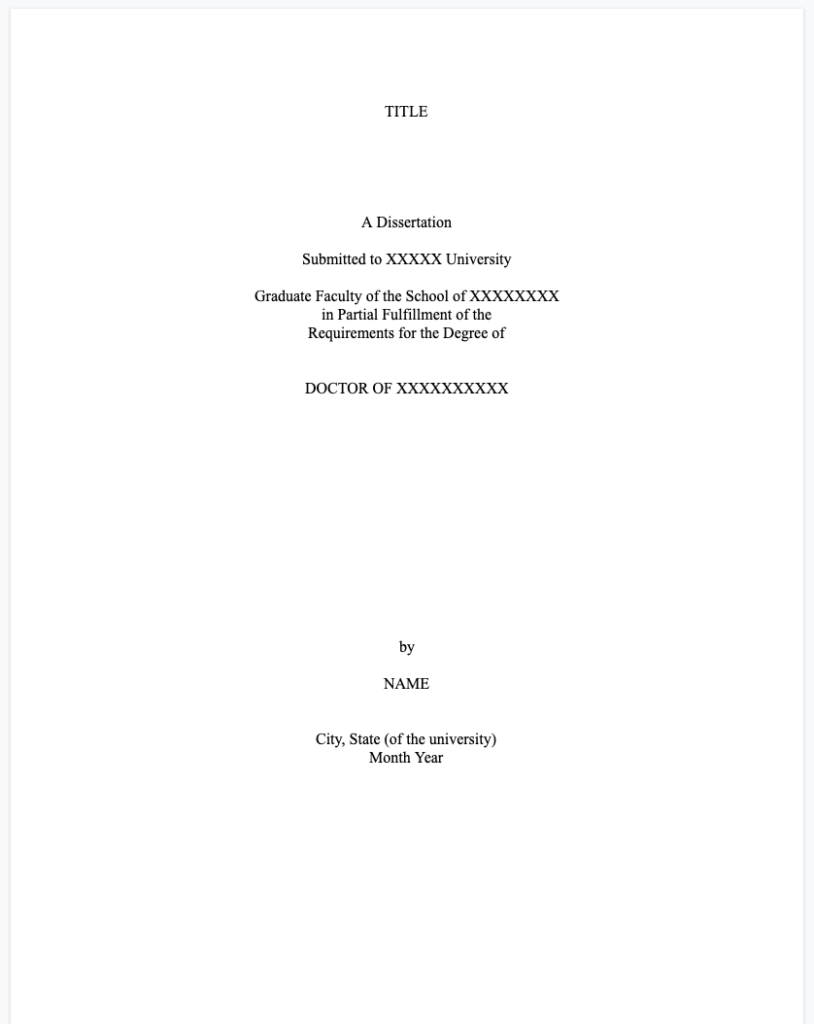
While each university has slightly different requirements, generally speaking, a dissertation cover page looks something like this, above. The required sections are as follows:
A Dissertation
Submitted to XXXXX University
Graduate Faculty of the School of XXXXXXXX
in Partial Fulfillment of the
Requirements for the Degree of
DOCTOR OF XXXXXXXXXX
City, State (of the university)
Final Thoughts
While your dissertation title page doesn’t have to be fancy, it’s important that it aligns with your university’s requirements. Take a look at their rubric and, if needed, look at completed dissertations’ title pages as well. If all else fails, ask your mentor for help.
Once you’ve finished this, pat yourself on the back. You’re almost done!
PS. Need support getting through the final stages of your dissertation, or moving into the world of your career? As a dissertation coach and career coach , I’ve helped countless students achieve their dreams. Let’s achieve yours. Book a free 30-minute consultation today.
Steve Tippins
Steve Tippins, PhD, has thrived in academia for over thirty years. He continues to love teaching in addition to coaching recent PhD graduates as well as students writing their dissertations. Learn more about his dissertation coaching and career coaching services. Book a Free Consultation with Steve Tippins
Related Posts


Dissertation
Dissertation memes.
Sometimes you can’t dissertate anymore and you just need to meme. Don’t worry, I’ve got you. Here are some of my favorite dissertation memes that I’ve seen lately. My Favorite Dissertation Memes For when you Read more…

Surviving Post Dissertation Stress Disorder
The process of earning a doctorate can be long and stressful – and for some people, it can even be traumatic. This may be hard for those who haven’t been through a doctoral program to Read more…

PhD by Publication
PhD by publication, also known as “PhD by portfolio” or “PhD by published works,” is a relatively new route to completing your dissertation requirements for your doctoral degree. In the traditional dissertation route, you have Read more…
- The Complete Guide to APA Format in 2020
APA Title Page / Cover Page
- Headings and Subheadings
- Discussion Section
- Websites and Online Sources
- Journals and Periodicals
- Other Print Sources
- Other Non-Print Sources
- In-text Citations
- Footnotes and Endnotes
- Using MyBib Responsibly
- Miscellaneous Questions

Details to include
The title page (also known as the cover page) is the front page of your paper. It should contain:
- The running head , a header at the top of the page.
- The first page number .
- The title of the paper
- The institution for which you writing.
Running head
The running head should be in the top-left corner of the page in uppercase. It should include a shortened title of your paper. On the front page only, it should also be prepended with "Running head:".
First page number
The first page number -- generally page 1 -- should be in the top-right corner of the page. Both the page number and the running head should be a half inch from the top of the page.
The title of the paper can contain upper and lowercase letters, and ideally should be no more than 12 words in length. It should be direct, and should not contain abbreviations or other unnecessary words. It should not span longer than 2 lines. The first letter of each word should be uppercase, except for articles (a, an, the), and conjunctions (and, but, for, or, yet).
Underneath the title should be your name (or the author's name if you're not the author). It should be displayed as the first name , middle initial , and last name . Do not add titles (such as Dr.) to the beginning, or qualifications (such as PhD) to the end of an author's name.
Your institution
Finally, underneath the author's name, state the full name of the institution or school you're writing the paper for.
The font for all text on the title page should be Times New Roman, size 12pt, with double line-spacing.
A correct title page will look like the below image:

After completing your title page you will move on to writing an abstract of your paper.
Home / Guides / Citation Guides / MLA Format / Creating an MLA title page
Creating an MLA title page
If you are writing a research paper in MLA style 9th edition for a class, then you may need to include an MLA format title page. An MLA title page is the cover of your paper, and they aren’t always required. So, how do you make a title page that adheres to the MLA formatting guidelines, and how do you know when you need one?
This page contains all the information you need to know to make the perfect MLA title page, so that you can prove that you are an expert researcher and get the best possible grade. This MLA sample paper will show you how the rest of your paper should be formatted.
Here’s a run-through of everything this page includes:
Title page vs. MLA heading on first page
Title page / cover page, first page: mla heading (no title page), troubleshooting.
The current edition of the Modern Language Association (MLA) handbook does not require a title page , but your teacher, professor, or other reader may require one. In this case, you will need to know the differences between a title page and an MLA heading, and which one to use depending on your reader’s preferences. Other citation styles look slightly different, like this APA title page .
A title page, or a cover page, is a single page that comes before your MLA abstract (if required) and the content of your paper. It introduces your paper and quickly shows a reader the following information about your paper:
- author name (your name, since you wrote the paper)
- course information (if applicable)
It does not include any of the research paper itself.
First page with MLA heading
MLA format recommends adding an MLA heading to the first page of your paper. This contains the same information as a title page, but the information is formatted differently and is on the same page on which your actual research paper begins.
Unless otherwise specified by your instructor or teacher, this should be how you format your first page.
Before you start typing your MLA research paper title page, you will need to gather some information.
What you will need
If you are creating an MLA heading on the first page of your essay instead of a title page, you will need most of the same information, but you will format it differently.
To create a title page, you need to include:
- The name of your high school, college, or university (if applicable)
- The title of your paper
- The subtitle of your paper (if you have one)
- Your first and last name
- Your teacher or professor’s name (if applicable)
- The class name or course number (if applicable)
- The date the paper is due (in “day month year” format)
Formatting guidelines
Follow these formatting guidelines when typing your MLA title page:
- Double-spaced
- Times New Roman font
- Size 12 font
- The first letter of each word should be capitalized, with the exception of very short words such as the, and, of, or, a, an, for, in , etc. However, the first word should always be capitalized.
- Do not include a page number heading on your title page
Step-by-step instructions
Here are the steps you need to take to create the perfect MLA title page:
- At the top of the page, type the name of your high school, college, or university (if applicable).
- Skip down approximately one-third of the page and type the title of your research paper using title case.
- If you have a subtitle, type it on the line following the paper title.
- Skip down to the bottom third of the page and type your first and last name.
- On the following line, type the course name and number (if applicable).
- On the following line, type your instructor’s name (if applicable).
- On the following and final line, type the due date of your paper in “day month year” format.

Although it’s important to know how to create an MLA essay title page in case your instructor requires it, in most cases you will use an MLA heading on the first page of your paper instead.
Remember, you should only create a title page if your instructor requests it .
Otherwise, use these guidelines to create an MLA heading. If you create a title page, then you usually won’t need an MLA heading on your first page, but you should ask your instructor for their specific requirements.
To create an MLA heading on your first page, you will need to include some of the same information you would use for a title page, including:
- Left-justified text for MLA header
- Centered text for title
- Right-justified text for page number header
- In the top left corner of the first page of your essay, type your first and last name.
- On the following line, type the due date of your paper in “day month year” format.
- On the following line, switch from left-justified text to centered text and type the title (and the subtitle on the same line, if you have one) of your paper in title case. Do not italicize, underline, or place your essay title in quotation marks. Do not use quotation marks unless you are referring to other works in your title and need to enclose the referenced works in quotation marks.
- Your research paper should begin on the following double-spaced line.
- Create a right-justified text header one-half inch from the top of your paper that includes your last name and the page number.
- All pages of your paper should be numbered with your last name and the numerical page number. The page including your MLA header, title, and the beginning of your essay is page one (1).
- Your instructor may specify not to include a last name and page number header on your first page. Always follow your instructor’s guidelines.

Solution #1: What should I do if my paper is a group project?
If you have written a collaborative paper with multiple authors, list each author on your MLA title page or in your MLA heading in alphabetical order, with line breaks between each.
If your paper has multiple authors, omit the name from your page numbers in the upper-right corner of your MLA-format paper.
Example MLA heading for a group paper:

Example MLA title page for a group paper:

Solution #2: What should I do if my paper isn’t for a specific class?
If your paper is a thesis project for your degree, for example, or not for a specific class, you can omit that information from your MLA title page or MLA header.
Solution #3: Does my paper need a subtitle if I use a full MLA title page?
While an MLA title page allows for a subtitle beneath the title of your paper, it is NOT required to have a subtitle or make one up for your MLA title page.
If you didn’t intend to have a subtitle for your paper, there is no need to add a subtitle. Just leave that area of your MLA title page blank.
Solution #4: Will my MLA title page be part of my final page count?
A title page is not typically included in a paper’s final word count. Check with the teacher or professor assigning the paper to be sure, but it is highly unlikely a title page will count as a full page of your final paper.
Published October 25, 2020. Updated June 4, 2021
Written by Grace Turney , freelance writer and artist. Grace is a former librarian and has a Master’s degree in Library Science and Information Technology.
MLA Formatting Guide
MLA Formatting
- Annotated Bibliography
- Bibliography
- Block Quotes
- et al Usage
- In-text Citations
- Paraphrasing
- Page Numbers
- Sample Paper
- Works Cited
- MLA 8 Updates
- MLA 9 Updates
- View MLA Guide
Citation Examples
- Book Chapter
- Journal Article
- Magazine Article
- Newspaper Article
- Website (no author)
- View all MLA Examples
How useful was this post?
Click on a star to rate it!
We are sorry that this post was not useful for you!
Let us improve this post!
Tell us how we can improve this post?
The title page in MLA style gives basic information such as the name, the instructor’s name, the course name and number, the title of the paper, and the submission date. MLA style does not recommend using a title page unless specifically requested by your instructor; instead, it suggests creating a header.
The difference between a title page and a header in MLA style is that a title page appears as a page on its own before the main paper copy. A header, on the other hand, appears on the same page where paper copy begins.
Include the following elements on a title page. Follow the order as given below.
The university name
The title and subtitle of the paper
The course name and number
The instructor’s name
The submission/due date
If you are not required to create a title page, and only need a header, the following elements should be included in the header, in the order as listed:
While MLA does not generally recommend the use of a title page, some courses or professors may require it. The title page should include the university name, title of the paper, your name, the instructor’s name, the course name, and the submission or due date.
Formatting title page
MLA style does not have any specific guidelines for formatting a title page. However, you can use the below suggestions to format your title page if you are required to create one for your paper.
Page margins
All margins (top, bottom, left, and right) should be set at 1 inch.
The font should be clear and easy to read. A good option is Times New Roman font in size 12 pt.
Text on the title page should be double-spaced.
Elements of a title page
Include the following elements on the title page. Follow the order as given below.
Add a few blank lines before and after the title of the work. The title should be in title case and centered.
Beginning on the title page, the paper should also include a running head. The running head includes the your last name and the page number. This should be placed in the “header” area of the paper so that it is present on each page. Use the page number feature in your word processor so that the page number is generated automatically.
Example title page
Chegg University
Relationship Between Students and Their Teachers
Ishithaa Gopi
Psychology 127
Professor John Smith
21 September 2021
MLA Citation Examples
Writing Tools
Citation Generators
Other Citation Styles
Plagiarism Checker
Upload a paper to check for plagiarism against billions of sources and get advanced writing suggestions for clarity and style.
Get Started
- Sample Dissertation Title Page
- Dissertation Copyright
- Dissertation Embargo Guidelines
- Dissertation Templates
- ETD Administrator
- Formatting FAQs
Dissertation title pages must follow a specific format. Refer to the PhD Dissertation Formatting Guide and view the examples below. Certain graduate groups follow a special format.
Standard sample title page (exceptions listed below):

Students in Francophone, Italian and Germanic Studies (FIGS) must follow the format below:
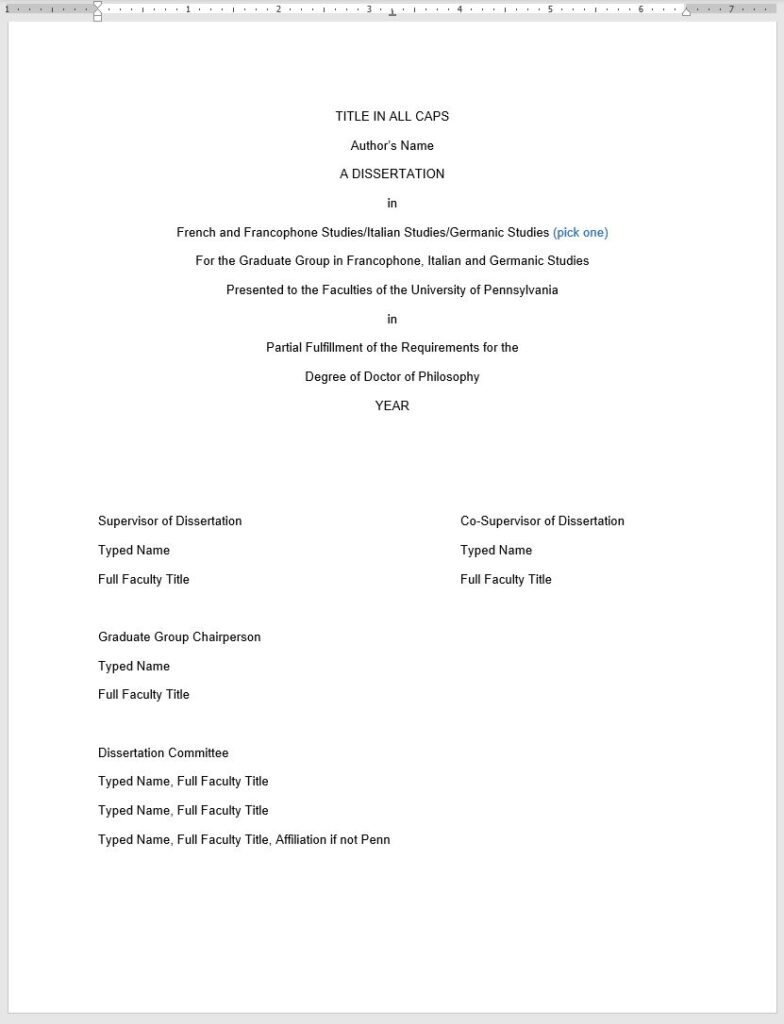
Students in Wharton must follow the format below:
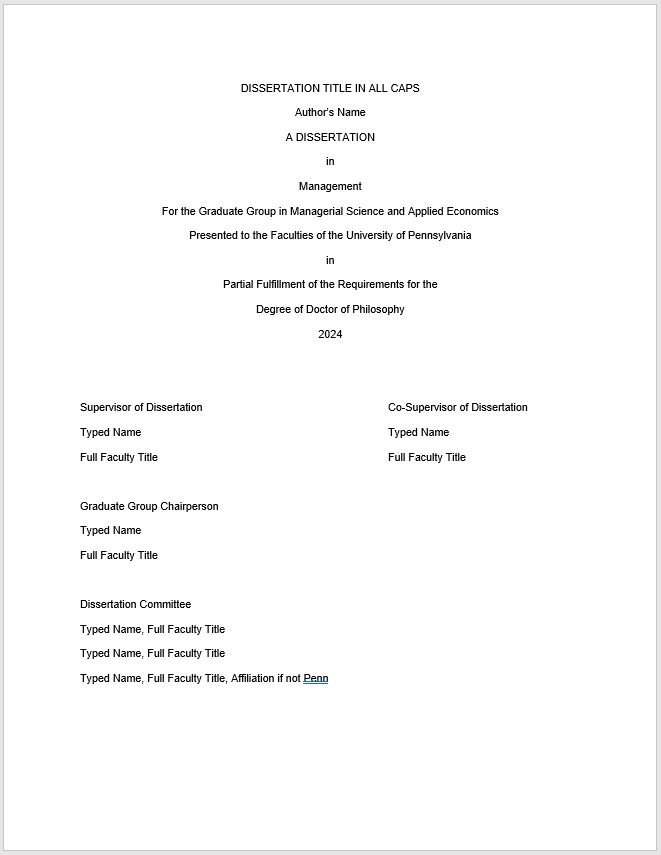
Students in the Social Welfare Graduate Group must follow this format:
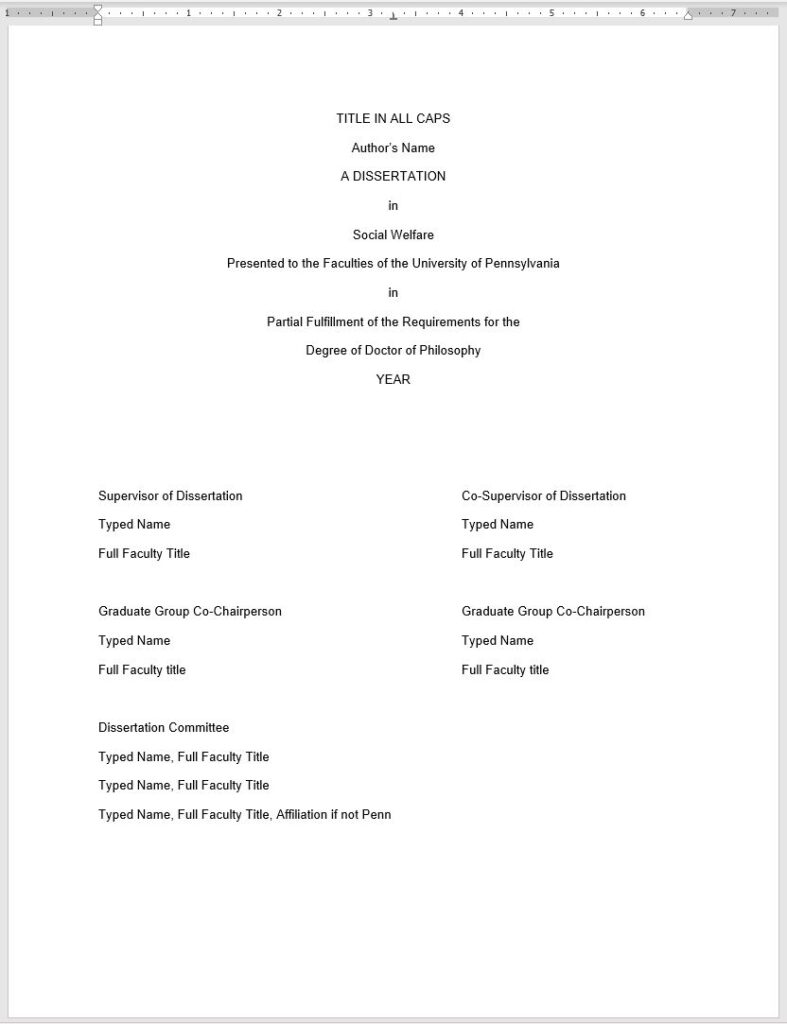
No Search Results
How to Write a Thesis in LaTeX (Part 5): Customising Your Title Page and Abstract
Part 1 | Part 2 | Part 3 | Part 4 | Part 5
Author: Josh Cassidy (August 2013)
This five-part series of articles uses a combination of video and textual descriptions to teach the basics of writing a thesis using LaTeX. These tutorials were first published on the original ShareLateX blog site during August 2013; consequently, today's editor interface (Overleaf) has changed considerably due to the development of ShareLaTeX and the subsequent merger of ShareLaTeX and Overleaf. However, much of the content is still relevant and teaches you some basic LaTeX—skills and expertise that will apply across all platforms.
In the previous post we looked at adding a bibliography to our thesis using the biblatex package . In this, the final post of the series, we're going to look at customising some of the opening pages. In the first video we made a rather makeshift title page using the \maketitle command and by using an \includegraphics command in the \title command. Although this works, it doesn't give us as much flexibility as we may want.
The Title Page
A much better way to do this is to use the titlepage environment. We'll do this in a separate .tex file and then input it. The first thing we'll do is enclose everything in the title page within the center environment so it's all aligned to the centre. Next we need to instruct L a T e X to leave a gap between the top of the page and the first line of text. To do this we use the \vspace command followed by a length. We also need to add an asterisk into the command to make sure L a T e X doesn't decide to ignore the command. Next we'll add the thesis title in bold font using the \textbf command. To leave a gap between this and the next line of text we use the \vspace command again, this time without the asterisk. Next we'll add in a subtitle followed by some more vertical space and then the author name in bold font. This concludes what we want at the top of the title page—the rest of the content we'll add at the bottom of the title page.
To separate these two sections out we'll use the \vfill command which will automatically add in the amount of vertical space needed for the content to fill the page. Next we'll add in a line of text to specify what degree the thesis is being submitted for. The double backslash is used to create a new line. We'll then add more space before adding in the university logo specifying it's width as a fraction of the text width. Finally we'll add in some information about the university and the date.
Now in the main .tex file we can replace the \maketitle command with an input command linked to our new title page. If we now compile the code we can see all the items have been correctly processed:
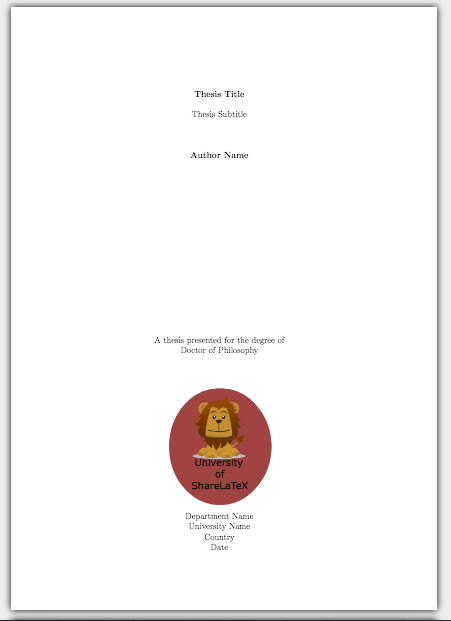
However, the text is quite small so we'll go back and change the font sizes. To do this we'll use one of the simple font-sizing commands. There are ten of these to choose from, ranging from smallest to largest they are:
Let's make the title as big as it can be (using these simple commands) by choosing \Huge . We'll then make the subtitle two steps smaller using \large . When we use one of these commands they affect all the text in it's scope. Therefore in it's current state all the remaining text on the page will appear in the size of the subtitle. We'll keep it like this for the author name and degree title but we'll drop down one size for the university details and the date:
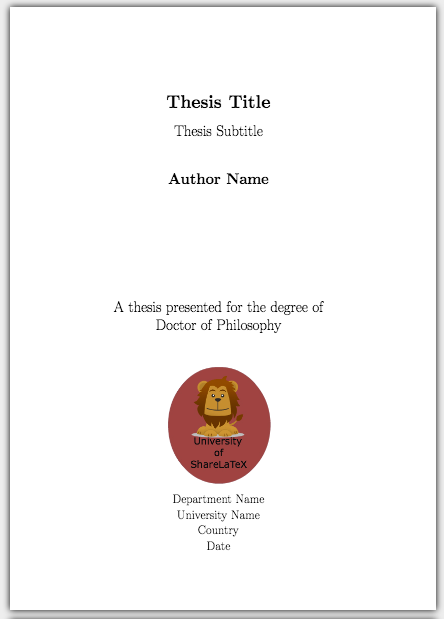
The abstract
We can also customise other pages, such as the abstract. Instead of using an unnumbered chapter, we'll create a new .tex file, customise the layout and then input it. At the top of this file we need to change the page style to plain in order to stop the headers being added in. Now in a similar way to the title page we'll add in some custom titles and then the abstract text.
This is what it will look like added in:
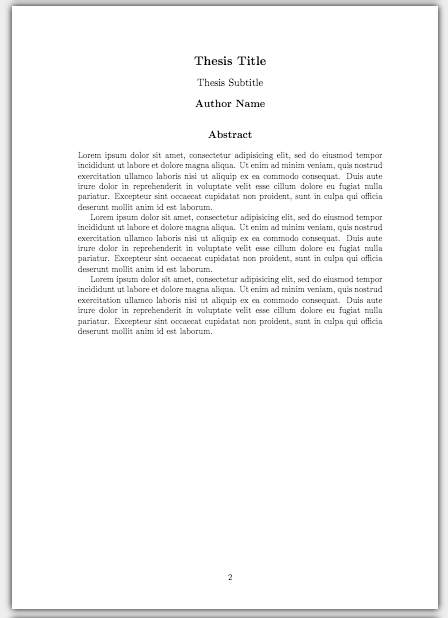
This concludes our series on writing a basic thesis. If you want to play around with the thesis we've created in this series you can open the project in Overleaf .
All articles in this series
- Part 1: Basic Structure ;
- Part 2: Page Layout ;
- Part 3: Figures, Subfigures and Tables ;
- Part 4: Bibliographies with BibLaTeX ;
- Part 5: Customising Your Title Page and Abstract .
- Documentation Home
- Learn LaTeX in 30 minutes
Overleaf guides
- Creating a document in Overleaf
- Uploading a project
- Copying a project
- Creating a project from a template
- Using the Overleaf project menu
- Including images in Overleaf
- Exporting your work from Overleaf
- Working offline in Overleaf
- Using Track Changes in Overleaf
- Using bibliographies in Overleaf
- Sharing your work with others
- Using the History feature
- Debugging Compilation timeout errors
- How-to guides
- Guide to Overleaf’s premium features
LaTeX Basics
- Creating your first LaTeX document
- Choosing a LaTeX Compiler
- Paragraphs and new lines
- Bold, italics and underlining
Mathematics
- Mathematical expressions
- Subscripts and superscripts
- Brackets and Parentheses
- Fractions and Binomials
- Aligning equations
- Spacing in math mode
- Integrals, sums and limits
- Display style in math mode
- List of Greek letters and math symbols
- Mathematical fonts
- Using the Symbol Palette in Overleaf
Figures and tables
- Inserting Images
- Positioning Images and Tables
- Lists of Tables and Figures
- Drawing Diagrams Directly in LaTeX
- TikZ package
References and Citations
- Bibliography management with bibtex
- Bibliography management with natbib
- Bibliography management with biblatex
- Bibtex bibliography styles
- Natbib bibliography styles
- Natbib citation styles
- Biblatex bibliography styles
- Biblatex citation styles
- Multilingual typesetting on Overleaf using polyglossia and fontspec
- Multilingual typesetting on Overleaf using babel and fontspec
- International language support
- Quotations and quotation marks
Document structure
- Sections and chapters
- Table of contents
- Cross referencing sections, equations and floats
- Nomenclatures
- Management in a large project
- Multi-file LaTeX projects
- Lengths in L a T e X
- Headers and footers
- Page numbering
- Paragraph formatting
- Line breaks and blank spaces
- Text alignment
- Page size and margins
- Single sided and double sided documents
- Multiple columns
- Code listing
- Code Highlighting with minted
- Using colours in LaTeX
- Margin notes
- Font sizes, families, and styles
- Font typefaces
- Supporting modern fonts with X Ǝ L a T e X
Presentations
- Environments
Field specific
- Theorems and proofs
- Chemistry formulae
- Feynman diagrams
- Molecular orbital diagrams
- Chess notation
- Knitting patterns
- CircuiTikz package
- Pgfplots package
- Typesetting exams in LaTeX
- Attribute Value Matrices
Class files
- Understanding packages and class files
- List of packages and class files
- Writing your own package
- Writing your own class
Advanced TeX/LaTeX
- In-depth technical articles on TeX/LaTeX
Get in touch
Have you checked our knowledge base ?
Message sent! Our team will review it and reply by email.
Email:
How to Craft Your Ideal Thesis Research Topic
.webp)
Table of contents

Catherine Miller
Writing your undergraduate thesis is probably one of the most interesting parts of studying, especially because you get to choose your area of study. But as both a student and a teacher who’s helped countless students develop their research topics, I know this freedom can be just as intimidating as it is liberating.
Fortunately, there’a a step-by-step process you can follow that will help make the whole process a lot easier. In this article, I’ll show you how to choose a unique, specific thesis topic that’s true to your passions and interests, while making a contribution to your field.
.webp)
Choose a topic that you’re interested in
First things first: double-check with your teachers or supervisor if there are any constraints on your research topic. Once your parameters are clear, it’s time to identify what lights you up — after all, you’re going to be spending a lot of time thinking about it.
Within your field of study, you probably already have some topics that have grabbed your attention more than others. This can be a great place to start. Additionally, consider using the rest of your academic and extra-curricular interests as a source of ideas. At this stage, you only need a broad topic before you narrow it down to a specific question.
If you’re feeling stuck, here are some things to try:
- Look back through old course notes to remind yourself of topics you previously covered. Do any of these inspire you?
- Talk to potential supervisors about your ideas, as they can point you toward areas you might not have considered.
- Think about the things you enjoy in everyday life — whether that’s cycling, cinema, cooking, or fashion — then consider if there are any overlaps with your field of study.
- Imagine you have been asked to give a presentation or record a podcast in the next three days. What topics would you feel confident discussing?
- Watch a selection of existing lectures or explainer videos, or listen to podcasts by experts in your field. Note which topics you feel curious to explore further.
- Discuss your field of study with teachers friends and family, some with existing knowledge and some without. Which aspects do you enjoy talking about?
By doing all this, you might uncover some unusual and exciting avenues for research. For example, when writing my Master’s dissertation, I decided to combine my field of study (English teaching methodology) with one of my passions outside work (creative writing). In my undergraduate course, a friend drew on her lived experience of disability to look into the literary portrayal of disability in the ancient world.
Do your research
Once you’ve chosen your topic of interest, it’s time to dive into research. This is a really important part of this early process because it allows you to:
- See what other people have written about the topic — you don’t want to cover the same old ground as everyone else.
- Gain perspective on the big questions surrounding the topic.
- Go deeper into the parts that interest you to help you decide where to focus.
- Start building your bibliography and a bank of interesting quotations.
A great way to start is to visit your library for an introductory book. For example, the “A Very Short Introduction” series from the Oxford University Press provides overviews of a range of themes. Similar types of overviews may have the title “ A Companion to [Subject]” or “[Subject] A Student Companion”. Ask your librarian or teacher if you’re not sure where to begin.
Your introductory volume can spark ideas for further research, and the bibliography can give you some pointers about where to go next. You can also use keywords to research online via academic sites like JStor or Google Scholar. Check which subscriptions are available via your institution.
At this stage, you may not wish to read every single paper you come across in full — this could take a very long time and not everything will be relevant. Summarizing software like Wordtune could be very useful here.
Just upload a PDF or link to an online article using Wordtune, and it will produce a summary of the whole paper with a list of key points. This helps you to quickly sift through papers to grasp their central ideas and identify which ones to read in full.

Get Wordtune for free > Get Wordtune for free >
You can also use Wordtune for semantic search. In this case, the tool focuses its summary around your chosen search term, making it even easier to get what you need from the paper.

As you go, make sure you keep organized notes of what you’ve read, including the author and publication information and the page number of any citations you want to use.
Some people are happy to do this process with pen and paper, but if you prefer a digital method, there are several software options, including Zotero , EndNote , and Mendeley . Your institution may have an existing subscription so check before you sign up.
Narrowing down your thesis research topic
Now you’ve read around the topic, it’s time to narrow down your ideas so you can craft your final question. For example, when it came to my undergraduate thesis, I knew I wanted to write about Ancient Greek religion and I was interested in the topic of goddesses. So, I:
- Did some wide reading around the topic of goddesses
- Learned that the goddess Hera was not as well researched as others and that there were some fascinating aspects I wanted to explore
- Decided (with my supervisor’s support) to focus on her temples in the Argive region of Greece

As part of this process, it can be helpful to consider the “5 Ws”: why, what, who, when, and where, as you move from the bigger picture to something more precise.
Why did you choose this research topic?
Come back to the reasons you originally chose your theme. What grabbed you? Why is this topic important to you — or to the wider world? In my example, I knew I wanted to write about goddesses because, as a woman, I was interested in how a society in which female lives were often highly controlled dealt with having powerful female deities. My research highlighted Hera as one of the most powerful goddesses, tying into my key interest.
What are some of the big questions about your topic?
During your research, you’ll probably run into the same themes time and time again. Some of the questions that arise may not have been answered yet or might benefit from a fresh look.
Equally, there may be questions that haven’t yet been asked, especially if you are approaching the topic from a modern perspective or combining research that hasn’t been considered before. This might include taking a post-colonial, feminist, or queer approach to older texts or bringing in research using new scientific methods.
In my example, I knew there were still controversies about why so many temples to the goddess Hera were built in a certain region, and was keen to explore these further.
Who is the research topic relevant to?
Considering the “who” might help you open up new avenues. Is there a particular audience you want to reach? What might they be interested in? Is this a new audience for this field? Are there people out there who might be affected by the outcome of this research — for example, people with a particular medical condition — who might be able to use your conclusions?
Which period will you focus on?
Depending on the nature of your field, you might be able to choose a timeframe, which can help narrow the topic down. For example, you might focus on historical events that took place over a handful of years, look at the impact of a work of literature at a certain point after its publication, or review scientific progress over the last five years.
With my thesis, I decided to focus on the time when the temples were built rather than considering the hundreds of years for which they have existed, which would have taken me far too long.
Where does your topic relate to?
Place can be another means of narrowing down the topic. For example, consider the impact of your topic on a particular neighborhood, city, or country, rather than trying to process a global question.
In my example, I chose to focus my research on one area of Greece, where there were lots of temples to Hera. This meant skipping other important locations, but including these would have made the thesis too wide-ranging.
Create an outline and get feedback
Once you have an idea of what you are going to write about, create an outline or summary and get feedback from your teacher(s). It’s okay if you don’t know exactly how you’re going to answer your thesis question yet, but based on your research you should have a rough plan of the key points you want to cover. So, for me, the outline was as follows:
- Context: who was the goddess Hera?
- Overview of her sanctuaries in the Argive region
- Their initial development
- Political and cultural influences
- The importance of the mythical past
In the final thesis, I took a strong view on why the goddess was so important in this region, but it took more research, writing, and discussion with my supervisor to pin down my argument.
To choose a thesis research topic, find something you’re passionate about, research widely to get the big picture, and then move to a more focused view. Bringing a fresh perspective to a popular theme, finding an underserved audience who could benefit from your research, or answering a controversial question can make your thesis stand out from the crowd.
For tips on how to start writing your thesis, don’t miss our advice on writing a great research abstract and a stellar literature review . And don’t forget that Wordtune can also support you with proofreading, making it even easier to submit a polished thesis.
How do you come up with a research topic for a thesis?
To help you find a thesis topic, speak to your professor, look through your old course notes, think about what you already enjoy in everyday life, talk about your field of study with friends and family, and research podcasts and videos to find a topic that is interesting for you. It’s a good idea to refine your topic so that it’s not too general or broad.
Do you choose your own thesis topic?
Yes, you usually choose your own thesis topic. You can get help from your professor(s), friends, and family to figure out which research topic is interesting to you.
Share This Article:

How to Craft an Engaging Elevator Pitch that Gets Results
.webp)
Eight Steps to Craft an Irresistible LinkedIn Profile
.webp)
7 Common Errors in Writing + How to Fix Them (With Examples)
Looking for fresh content, thank you your submission has been received.

IMAGES
VIDEO
COMMENTS
Learn how to format your title page (or cover page) for your thesis, dissertation, or research paper. Find free templates and examples for APA and MLA style.
Learn how to format your APA title page according to the 7th edition rules. See examples of student and professional title pages, and tips on how to include an image or an author note.
Formatting Rules. In APA Style (7th edition), the cover page, or title page, should include: A running head (professional papers only) and page number. The title of the paper. The name of the author (s) The institutional affiliation. An author note; optional (professional papers only) A student paper should also include course information.
Learn how to create a title page for your APA Style paper, whether it is a student or a professional version. See examples, guidelines, and tips for formatting the title, author names, affiliation, course information, and more.
Learn how to format and design the title page of your thesis, dissertation, or research paper. Find templates, examples, and guidelines for APA, MLA, and other styles.
There are many ways to use Microsoft Word to create this page; one way to do this is demonstrated in the video below. Note for dissertations: The order in which you list your committee members differs from the order on the title page of the thesis. All committee members (other than the chair or co-chairs) are listed in alphabetical order based ...
Download a free dissertation template with clear instructions and examples for each section, including the cover page. The template is based on the best-practice format for academic research projects and can be edited in Word or LaTeX.
Learn how to write the title page of your dissertation or thesis, also known as the cover page, according to your university's requirements. See an example of a title page for a Masters degree project in the UK.
Section 1: The Cover Page 6 Main Components of the Cover Page 1. Title of your Thesis/Dissertation (only section to be double-spaced on the Cover Page) 2. Your legal name (as found on MyUNLV) 3. A list of any degrees equivalent to a bachelor's degree or higher that have already been conferred (see examples for how to format this section) 4.
68 templates. Create a blank Research Paper Cover Page. Brown Scrapbook Art Project Cover A4 Document. Document by Olmos Carlos. White Purple Simple Modern Proposal Cover A4 Document. Document by Rayhan Studio. Green and White Doodle Science Project Cover A4 Document. Document by Noisy Frame.
The Title Page of a Dissertation. A title page (also sometimes referred to as a cover page) is the first thing that your evaluator or any reader will see when they encounter your dissertation. It must contain important information that gives the reader an idea of what they are about to look at. Let's spend some time deconstructing this.
Download and customize ten beautiful cover page templates for various academic disciplines in MS Word format. Learn tips and guidelines for creating an effective dissertation cover page that reflects your research topic and meets the formatting requirements of your institution.
Sample Dissertation Title Page. While each university has slightly different requirements, generally speaking, a dissertation cover page looks something like this, above. The required sections are as follows: TITLE. A Dissertation. Submitted to XXXXX University. Graduate Faculty of the School of XXXXXXXX. in Partial Fulfillment of the.
The title page (also known as the cover page) is the front page of your paper. It should contain: The running head, a header at the top of the page. The first page number. The title of the paper; Your name; The institution for which you writing. Running head. The running head should be in the top-left corner of the page in uppercase. It should ...
Learn how to write a cover page for your essay in APA or MLA style. Find examples, tips, and a title page generator tool.
A title page, or a cover page, is a single page that comes before your MLA abstract (if required) and the content of your paper. It introduces your paper and quickly shows a reader the following information about your paper: ... If your paper is a thesis project for your degree, for example, or not for a specific class, you can omit that ...
Dissertation title pages must follow a specific format. Refer to the PhD Dissertation Formatting Guide and view the examples below. Certain graduate groups follow a special format. Standard sample title page (exceptions listed below): Exceptions Students in Francophone, Italian and Germanic Studies (FIGS) must follow the format below:
In the previous post we looked at adding a bibliography to our thesis using the biblatex package.In this, the final post of the series, we're going to look at customising some of the opening pages. In the first video we made a rather makeshift title page using the \maketitle command and by using an \includegraphics command in the \title command. Although this works, it doesn't give us as much ...
8,052 templates. Create a blank Cover Page. Pastel Colors Modern Minimal Portfolio Cover Page A4 Document. Document by Mister Flanagan Design. White Modern Wave Graphic Designer Portfolio Cover a4 Document. Document by Ramdhaniyah Mumtazah's. Brown Vintage Scrapbook Cover Project History Document (A4) Document by hanysa.
First, open a new document in Microsoft Word. Click on the Insert tab to find the drop-down menu for cover page templates. From there, you can choose which template you'd like to use for your project. When you click on a template, it will appear as the first page of your document.
A Report Cover Page Template is a pre-formatted design that serves as the front page of a report, providing essential information about the document in a structured and visually appealing way. This includes details like the report title, author's name, submission date, and other relevant data. The template we created earlier is versatile and ...
Choose a topic that you're interested in. First things first: double-check with your teachers or supervisor if there are any constraints on your research topic. Once your parameters are clear, it's time to identify what lights you up — after all, you're going to be spending a lot of time thinking about it.